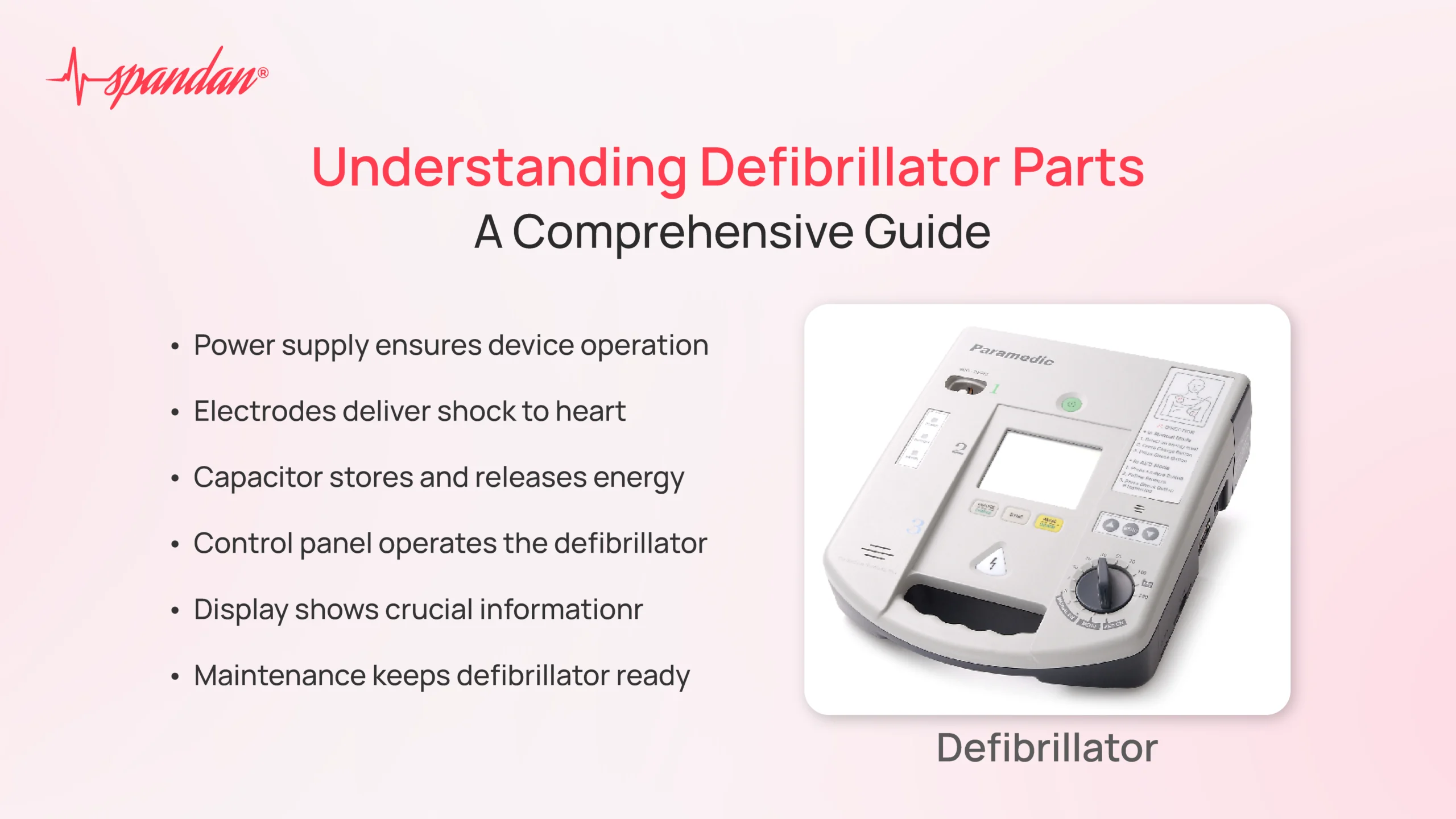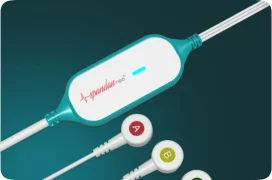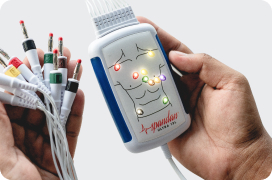
Related Article
Author:- Mr. Ritesh Sharma
When it comes to saving lives in emergency situations, defibrillators are one of the most crucial devices in the medical field. All defibrillator parts work together in symphoiny to help it save lives of individuals. These life-saving machines are designed to deliver an electric shock to the heart, helping to restore a normal heartbeat in cases of cardiac arrest. However, a defibrillator is more than just a single unit- it’s composed of several critical components that work together to perform this vital function. In this blog, we’ll take an in-depth look at the different defibrillator parts, understanding their roles and how they contribute to the overall operation of the device.
What are Defibrillator Parts?
Defibrillator parts refer to the individual components that make up a defibrillator device. Each part has a specific function, and together, they ensure the device operates efficiently and effectively during a cardiac emergency. Understanding these parts can help in maintaining the equipment, troubleshooting issues, and ensuring that the defibrillator is always ready for use when needed.
The Key Defibrillator Parts
A defibrillator is composed of several critical components that work together to deliver life-saving shocks during cardiac emergencies. The power supply energizes the device, while the electrodes (pads) deliver the shock to the patient’s heart. The capacitor stores and releases the necessary electrical energy, and the charging circuit ensures the capacitor is quickly charged. The control panel allows the user to operate the defibrillator, with the display screen providing vital information. Audio and visual prompts guide the user through the process, and ECG leads monitor the heart’s rhythm. The software and firmware control the device’s functions, ensuring accurate operation, while the housing and case protect all internal components from damage.
1. The Power Supply
The power supply is the heart of the defibrillator’s operation, providing the necessary energy to deliver a shock. Defibrillators can be powered by batteries or connected directly to an electrical outlet. In portable defibrillators, rechargeable batteries are commonly used, allowing the device to be mobile and ready for use in various settings. Ensuring the power supply is fully functional and charged is critical because, without it, the defibrillator cannot perform its life-saving function.
2. Electrodes (Pads)
Electrodes, commonly referred to as pads, are one of the most essential defibrillator parts. These pads are placed on the patient’s chest to deliver the electrical shock from the defibrillator to the heart. The placement of these electrodes is crucial—they must be positioned correctly to ensure the shock is delivered effectively. Modern defibrillators come with adhesive electrodes that are easy to place and remove, and they often include diagrams or instructions on proper placement. Regular checks to ensure the electrodes are in good condition and not past their expiration date are necessary to maintain their effectiveness.
3. The Capacitor
The capacitor is a key component among the defibrillator parts, responsible for storing and releasing the electrical energy needed to perform defibrillation. When the defibrillator is activated, the capacitor charges up to a specific voltage. Once charged, it releases this energy in a controlled burst, delivering the shock necessary to restart the heart. The efficiency and speed at which the capacitor charges and discharges are crucial for the timely delivery of the shock during a cardiac emergency.
4. The Control Panel
The control panel is where the user interacts with the defibrillator. It typically includes buttons, dials, or touch screens that allow the user to operate the device. Functions on the control panel may include turning the device on or off, adjusting the shock intensity, and initiating the shock delivery. The control panel also provides feedback, often through visual or auditory prompts, to guide the user during the defibrillation process. Among defibrillator parts, the control panel plays a critical role in ensuring the device is used correctly and efficiently.
5. The Charging Circuit
The charging circuit is responsible for preparing the capacitor to deliver a shock. When the defibrillator is activated, the charging circuit takes the power from the power supply and increases it to the required level to charge the capacitor. This part of the defibrillator must work quickly and reliably, as any delay in charging the capacitor can reduce the effectiveness of the shock. Regular maintenance checks are essential to ensure the charging circuit functions correctly.
6. The Display Screen
The display screen is another vital component among defibrillator parts, providing critical information to the user. It displays heart rhythms, instructions, battery status, and other important data during use. For Automated External Defibrillators (AEDs), the display might also show visual prompts or step-by-step instructions to guide even untrained users through the defibrillation process. A clear, functioning display screen is essential for effective defibrillator operation.
7. Audio and Visual Prompts
Many modern defibrillators are equipped with audio and visual prompts designed to guide the user through the defibrillation process. These prompts can be lifesaving in high-pressure situations, particularly for those who are not medical professionals. Audio prompts may include instructions on when to administer CPR or when to deliver a shock, while visual prompts might display the patient’s heart rhythm or other important information. These defibrillator parts ensure that even in chaotic emergency scenarios, the user can follow the correct steps to save a life.
8. ECG Leads
In advanced defibrillators, especially those used in hospitals, ECG leads are used to monitor the patient’s heart rhythm in real-time. These leads are attached to the patient’s body and transmit data to the defibrillator, allowing medical professionals to assess the heart’s activity before, during, and after defibrillation. ECG leads are crucial defibrillator parts that provide continuous monitoring, ensuring that the defibrillator is used appropriately and effectively.
9. Software and Firmware
While not a physical component, the software and firmware within a defibrillator are critical for its operation. This software controls the functions of the defibrillator, from analyzing the heart rhythm to determining whether a shock is necessary. It also ensures the device operates safely and efficiently. Regular updates to the software and firmware can improve the defibrillator’s functionality and add new features, making it one of the most important defibrillator parts to keep up-to-date.
10. The Housing and Case
Finally, the housing and case protect all the internal defibrillator parts, ensuring they remain intact and functional. The case is typically made from durable, impact-resistant materials that can withstand harsh environments and rough handling. It’s important that the housing remains undamaged, as any cracks or breaks could expose internal components to moisture, dust, or other elements that could impair the defibrillator’s function.
The Importance of Regular Maintenance of Defibrillator Parts
Regular maintenance of defibrillator parts is essential to ensure that the device is ready to use at any moment. This includes checking the battery levels, ensuring electrodes are not expired, and performing regular software updates. Hospitals, clinics, and even public spaces with AEDs should have routine checks scheduled to ensure all defibrillator parts are in working order.
Understanding the different defibrillator parts is crucial for anyone involved in healthcare or emergency response. From the power supply to the electrodes, each component plays a vital role in ensuring the defibrillator can perform its life-saving function. By maintaining these parts and understanding their functions, we can ensure that defibrillators are always ready to save lives when they’re needed most. Whether you’re a healthcare professional, an emergency responder, or someone responsible for public safety equipment, knowing these defibrillator parts can make all the difference in a critical situation.




